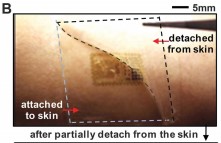
In 2011, John Rogers (in conjunction with several other researchers), released an article called “Epidermal Electronics” in Science Magazine. In it, Rogers’s team claimed to have optimized materials and electronics design to the degree that electronic sensors could be made to imitate key characteristics of the human skin.
The design challenge was to make circuitry that matched the skin’s thickness, elasticity, and, stiffness. These materials would also have to be small and lightweight enough so as to not influence the physiological processes they were meant to be measuring on the skin.
Rogers’s research group operated in a young, growing subfield of material science called flexible electronics. His specific innovation is of the wearable variety. Most of the cutting-edge technologies in this space were either wafer-based or not designed for use outside of clinical settings. Rogers’s research group was developing design theories for flexible electronics that would place sensors in direct, laminated contact with the skin via van der Waals forces alone.
They developed electronic systems that were:
Smaller: Optimized geometric designs of silicon and gallium arsenide electronics make these materials as thin as less than 7 nanometer and as light as 0.09 grams, which allows them to avoid interfering with physiological processes and allows them to bend and stretch with the skin. It also allows these materials to be worn for up to 24 hours.
More Durable: These systems were initially tested, in 2011, to be able to worn and give reliable measurements for up to 24 consecutive hours. Some commercial testing has made these tools viable for up to 5 days.
Multifunctional: These systems were designed to measure electronically detectable physiological process by placing sensors as close to the skin as possible. They included components such as LEDs, circuitry, wireless power sources, and radio frequency communication tools. In a contribution to a 2016 book, Rogers explains the various medical applications that the accurate heat measurements of the skin could provide.
Since the temperature of the skin has a quantitative relationship with things like hydration levels, changes in cognitive state, and cardiovascular health, this has been the primary interest of Rogers’s commercial outlet, MC10.
One of Rogers’s commercial products is the My UV Patch, developed for L’Oreal’s skin care brand in January 2016. This product partially fulfills the Rogers’s research group vision for giving people actionable, clinical insights about their health in real-time. It attaches to the skin like a sticker and has sensors that trigger a color change when the sticker (and by proxy the user’s skin) is exposed to harmful UV rays. It can be worn for up to five complete days. That’s five days of showering, swimming, whatever the user may like.
John Rogers left the University of Illinois in 2016 for Northwestern, but his Research Group has been as active as ever. Their work can be seen at: <http://rogersgroup.northwestern.edu/>. His time as an innovator at Illinois may be summarized with this quote from an interview with Bioelectronics in Medicine:
“There’s something more satisfying about working on scientific topics that have the potential for beneficial effects on human health than for a new display for a smart phone.”
Materials Science and Engineering Building – Former Office of John Rogers
MC10 website – Roger’s commercial company
Xu Research Group UCSD – another research group on electronics
Gomelsky, V. (2017). L’Oreal’s Technology Incubator: Creating the Future of Beauty. New York Times. Retrieved from https://www.nytimes.com/2017/03/30/fashion/craftsmanship-loreal-beauty-technology.html
Rogers, J. (2018). Professor John A. Rogers. Retrieved from rogersgroup.northwestern.edu.
Rogers, J. (2018). Interview with John Rogers. Bioelectronics in Medicine, 1(2). DOI: https://doi.org/10.2217/bem-2018-0004
Sekitani, T., Noguchi, Y., Hata K., et al. (2008). A Rubberlike Stretchable Active Matrix Using Elastic Conductors. Science, 321(5895), pp. 1468 – 1472. DOI: 10.1126/science.1160309
Webb, C.; Krishnan, S.; Rogers, J. (2016). Ultrathin, Skin-Like Devices for Precise, Continuous Thermal Property Mapping of Human Skin and Soft Tissues. Stretchable Bioelectronics for Medical Devices and Systems, 117-132. https://doi.org/10.1007/978-3-319-28694-5_6

